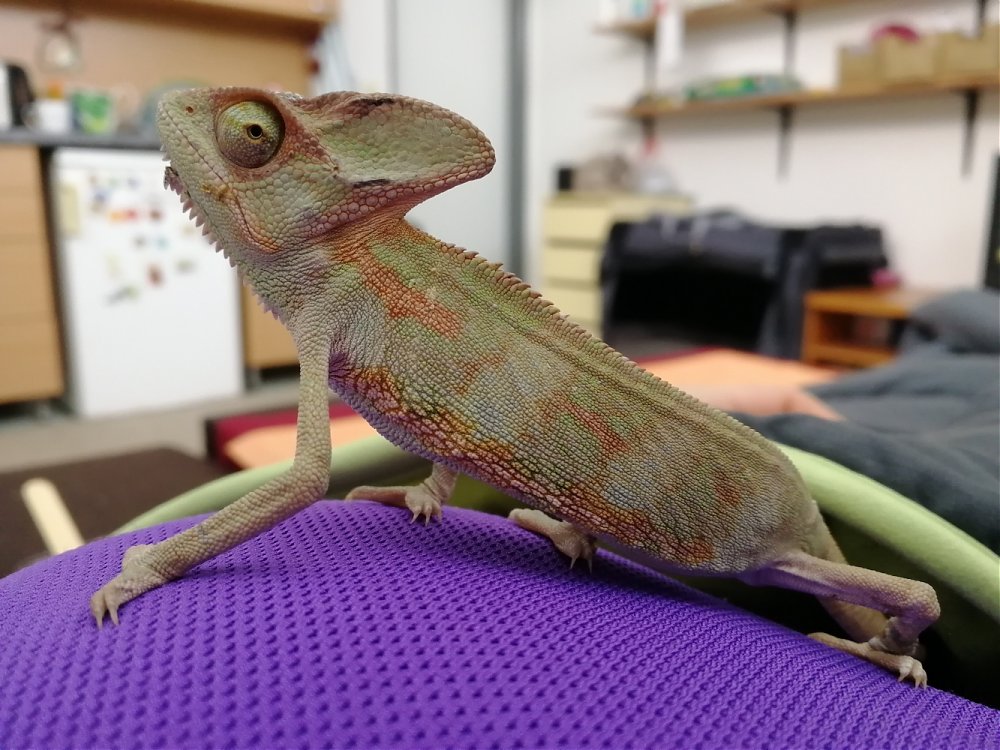
Chameleon breeding
As the breeding of these beautiful reptiles grows more and more in our country, we have prepared a summary of basic care for these exotic pets.
If you decide to get this extraordinary reptile, you must especially count on a spacious terrarium situated high. It should be at least 50x50x80 cm for adults and 100cm for males. Of course, we choose a smaller size terrarium for the young, because it could happen that they could not find food in the spacious terrarium. We translate them into a large terrarium at the age of 6 months. Ventilation should preferably be provided from the top and side so that the air can circulate without problems. The location should not be in a very exposed place, because the chameleon is quite shy. It is also not appropriate to put it on the ground, but rather up to your eyes, so that the pet has a view. It is advisable to place different branches and branches in the terrarium, because chameleons like to climb. Also plants, whether artificial or living. The advantage of living plants is that they help to maintain acceptable moisture inside the terrarium. From live plants we can place eg. Ficus, spleen, bromelia etc. Terrarium season 2-3 times a day, chameleon in adulthood once a day. But it is not an exaggeration. The terrarium should be dry within an hour. Substrate we choose eg. lignocel (pressed coconut substrate) mixed with sand in a 1: 1 ratio. The surface can be placed eg. withered leaves. This substrate is also suitable for growing live plants. No less important is to establish and let run the terrarium before buying a chameleon!
For beginners it is certainly better to get a male. Females often have problems with their egg laying conditions under inappropriate conditions and may die. This occurs, for example. under poor lighting conditions, insufficient moisture or substrate depth. For males this is not a threat. Males are larger, more colorful and can grow up to 50cm in length. We never keep more than one male in the same terrarium, as there could be fighting for territory. It is not advisable to breed male and female, as the male could sexually exhaust it. If you want to breed more chameleons, there are at least 3 females per male. But it is also necessary to adapt the dimensions of the terrarium and ensure that the females have the right conditions!
Chameleon needs a UVB light source in addition to a heating lamp to synthesize vitamin D3. Without this source of light, rickets would result and the individual would die. Therefore, chameleon calcium must also be supplied e.g. dusting the food with a special mixture. Needless to worry, excess calcium can easily eliminate out of the body. But they need to turn off their light sources at night. Most breeders follow the lighting conditions outside, i.e. in the summer shines 12-14 hours. and in winter 10hod. The temperature in the terrarium should be in the middle of about 26-27 ° C, under the bulb max 35 ° C. Moisture can be room. But don't forget
UVB bulb change every year!
Crickets, locusts, cockroaches are all suitable for feeding, all in an appropriate size to the individual. Fruits and vegetables can be served in small quantities, but most chameleons will not even notice. Chameleon grows all life, but at most the first year of life, so it must be fed daily. After a year we feed every second to third day. For feeding, we can use a feeder (opaque box) placed in branches and with an opening to get the chameleon easily. You can also feed it with tweezers, or leave it free in the terrarium. Bowl with water in the terrarium is not necessary, just enough dew.
Chameleons do not like to touch, so we handle them minimally (especially immediately after their purchase), because they suffer enough from stress. The biggest sign of trust of this reptile is when you climb on your hand :)
Chameleon can be released outside the terrarium, but only in a well-secured room, because they can move quite quickly and suddenly miss.
The male can live up to 5 years, the female usually 2-3 years. If you decide to buy and breed this extraordinary reptile, think carefully whether you can provide suitable breeding conditions and buy individuals, especially from certified breeds.
